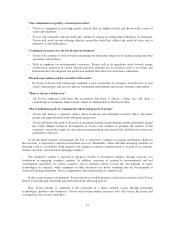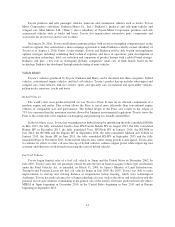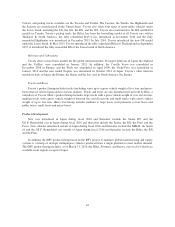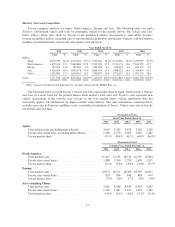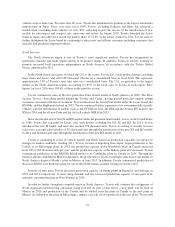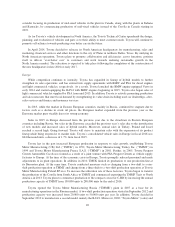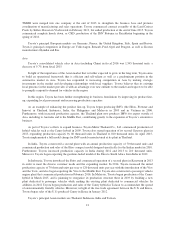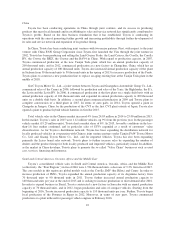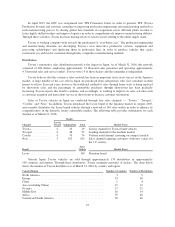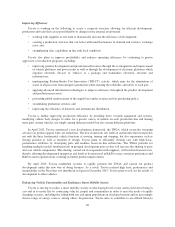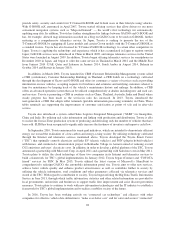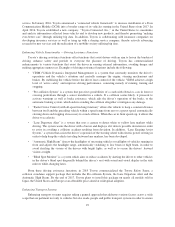Toyota 2015 Annual Report Download - page 27
Download and view the complete annual report
Please find page 27 of the 2015 Toyota annual report below. You can navigate through the pages in the report by either clicking on the pages listed below, or by using the keyword search tool below to find specific information within the annual report.China
Toyota has been conducting operations in China through joint ventures, and its success in producing
products that meet local demands and in establishing its sales and service network has significantly contributed to
Toyota’s profits. Based on the firm business foundation that it has established, Toyota is conducting its
operations with the aim of promoting further growth and increasing profitability through further development of
its sales and service network and expansion of its product lineup.
In China, Toyota has been conducting joint ventures with two major partners. First, with respect to the joint
venture with China FAW Group Corporation since Toyota first launched the Vios through the joint venture in
2002, Toyota has been producing and selling the Land Cruiser Prado, the Land Cruiser, the Corolla, the Corolla
HV, the Crown, the REIZ, the Coaster and the RAV4 in China. With regard to production capacity, in 2007,
Toyota commenced production at the new Tianjin Teda plant, which has an annual production capacity of
200 thousand units, and in 2012, commenced production at a new factory in Changchun, China, which has an
annual production capacity of 100 thousand units. Toyota also increased annual production capacity of the plant
in Sichuan from 30 thousand units to 50 thousand units in the spring of 2015 to increase production of the Prado.
Toyota plans to construct a new production line to replace an aging existing line at the Tianjin Teda plant in the
middle of 2018.
GAC Toyota Motor Co., Ltd., a joint venture between Toyota and Guangzhou Automobile Group Co., Ltd.,
commenced sales of the Camry in 2006, followed by production and sales of the Yaris, the Highlander, the E’z,
the Levin and the Levin HV. In 2006, it commenced production at the first plant on a single shift basis with an
annual production capacity of 100 thousand units and expanded its annual production capacity to 200 thousand
units on a double shift basis. In addition, a second plant commenced production in 2009 and Toyota plans to
complete construction of a third plant in 2017. In terms of auto parts, in 2014, Toyota opened a plant in
Changshu in Jiangsu, China for the production of the CVT as the first CVT plant outside of Japan. Toyota also
opened a plant to produce hybrid vehicle batteries in October 2015.
Total vehicle sales in the Chinese market increased 4% from 24.03 million in 2014 to 25.00 million in 2015.
In this market, Toyota’s sales in 2015 were 1.12 million vehicles, up 9% from the previous year. In the passenger
vehicle market (19.29 million units), Toyota had a market share of 6%. In 2015, favorable conditions in the less-
than-1.6 liter market continued, and in particular sales of SUVs expanded as a result of customers’ value
diversification. As for Toyota’s distribution network, Toyota has been expanding the distribution network for
locally produced vehicles in cooperation with Chinese joint venture partners under Tianjin FAW Toyota Motor
Co., Ltd. and Guanqi Toyota Motor Co., Ltd., and for imported vehicles, Toyota has also been expanding
primarily the Lexus brand sales network. Toyota plans to further increase sales by expanding the number of
dealers and the product lineup for both locally produced and imported vehicles, particularly inland. In addition,
as the market in China develops, Toyota plans to promote the so-called “Value Chain” businesses such as used
cars, services, financing and insurance.
South and Central America, Oceania, Africa and the Middle East
Toyota’s consolidated vehicle sales in South and Central America, Oceania, Africa and the Middle East
(collectively, the “Four Regions”) in fiscal 2016 were 1,594 thousand units, a decrease of 9.2% from fiscal 2015.
The core models in this region are global models such as the Corolla, IMV (the Hilux) and Camry. In order to
increase production of IMVs, Toyota expanded the annual production capacity of its Argentina factory from
70 thousand units to 90 thousand units in 2011. Toyota further increased annual production capacity to
140 thousand units per year at the end of 2015 and is seeking to increase production to meet demand after 2016.
In order to expand business in Brazil, Toyota constructed a new factory in Sorocaba with an annual production
capacity of 70 thousand units, and in 2012, began production and sales of compact vehicles. Starting from the
beginning of 2016, Toyota increased production capacity to 110 thousand units per year. Further, Toyota began
local production of the Fortuner in Egypt in 2012. Moreover, in terms of auto parts, Toyota commenced
production at a plant in Brazil for passenger vehicle engines in February 2016.
22


